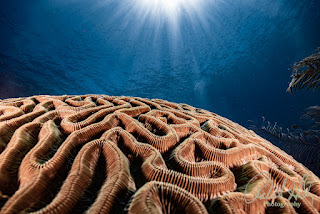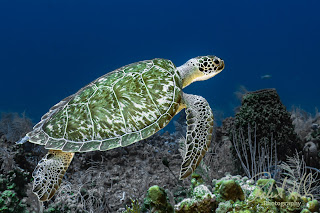Noise Reduction AI v2.0 for Underwater Photos: A Complete Guide to Cleaner, Sharper Results
📍Explore more tips at: Robert Herb Photography Blog
Have you ever reviewed your underwater images after a dive and found yourself feeling disappointed by one or more issues? Your shots exhibit excessive grain, murky color blotches, or subjects that appear soft and lack detail, particularly those taken in deeper waters or low-light conditions, such as swim-throughs. If this sounds familiar, you're not alone. Many underwater photographers encounter these challenges when trying to capture clear, vibrant images beneath the surface.
As underwater photographers, pushing the limits of your camera's ISO setting is often necessary. Whether your goal is to keep shutter speeds fast enough to freeze fast-moving marine life or to maximize the light from strobes and ambient sources in dark environments like caverns and wrecks, increasing ISO becomes an essential part of your shooting strategy. However, higher ISO settings have traditionally introduced their own set of problems, including increased noise and a loss of image quality.
Fortunately, technological advances in editing software have made it easier than ever to improve these images after your dive. With the release of Adobe Lightroom Classic 14.4 and Lightroom Mobile 9.4, the introduction of Noise Reduction AI version 2.0 marks a significant leap forward in enhancing the quality of underwater photos. These tools are specifically designed to reduce noise and grain, all while preserving important details and textures, so your images look clearer, crisper, and more lifelike without sacrificing quality.
In this guide, I'll share how I personally use these powerful AI Noise Reduction tools in Lightroom to enhance my underwater images. I'll explain how to preserve edge sharpness, recover authentic color fidelity, and regain fine textures—even in deep, ambient-light-only shots. Whether you're an avid diver or a professional underwater photographer, mastering these techniques will enable you to produce stunning images that truly capture the beauty of the underwater world.
💡 What's New in Noise Reduction AI v2.0?
Version 2.0 isn't just a speed bump; it's a significant overhaul of the algorithm.
Here's what's improved:
-
Better preservation of edge detail in textured subjects like coral, gill structures, and scales
-
More intelligent luminance noise detection in monochrome or blue-tinted midtones
-
Far less color bleeding around contrasting edges
-
Faster processing, even on large RAW files (DNG, CR3, ARW, etc.)
Compared to earlier versions, such as v1.0 released in 2023, this updated tool now has enhanced capabilities to analyze tone maps and texture overlays more deeply. This improvement enables it to distinguish fine marine details more effectively from actual noise. As a result, users can expect more accurate and detailed analysis, helping researchers and enthusiasts better interpret underwater images with confidence and clarity.
🛠 Workflow Example #1: Ambient-Light Wreck Shot at ISO 3200
📸 Use Case: Inside a sunken wreck, shot at 1/60s, f/4.5, ISO 3200
Steps:
-
Open the photo in the Develop Module
🔹 Shortcut:D -
Click 'Denoise' in the Detail Panel
🔹 Shortcut:Ctrl + Shift + D(Windows) /Cmd + Shift + D(Mac) -
AI automatically samples the image and recommends a Strength (e.g., 50%)
-
Tick "Enhanced Details" for texture preservation on metallic surfaces
-
Click 'Enhance' – Lightroom generates a new DNG with AI NR v2.0 applied
📝 Result: Grainy shadows inside the wreck hull smooth out without losing rivet details or algae patterns clinging to metal surfaces.
🛠 Workflow Example #2: Reef Scene at Dusk (ISO 2500)
📸 Use Case: Wide-angle reefscape with moving anthias and fans, twilight dive
Steps:
-
After applying AI NR v2.0 (same as above), proceed to the Masking Panel
🔹 Shortcut:Shift + W -
Add "Select Subject" mask on coral foreground
-
Add Texture (+20) and Clarity (+15) ONLY to the subject
-
Adjust the Color Noise Reduction slider manually to ~15-20 if reds are still muddy
🎯 Result: Fish movement blur remains natural, but background water looks cleaner and less speckled. Coral polyps stay sharp.
🛠 Workflow Example #3: Macro with Mixed Light at ISO 2000
📸 Use Case: Shooting a goby under a ledge using a focus light + ambient fill
Steps:
-
Apply AI NR v2.0 at 40–60% strength
-
In the Masking Panel, use the Luminance Range Mask to isolate the shadowy zone behind the goby
🔹 Location: Add Mask → Luminance Range -
Lift Shadows (+30) and apply Texture to the subject only
🔹 Shortcut for Brush Tool if refining:K -
In the Detail Panel, reintroduce Sharpening (Amount: 35, Radius: 1.0)
🔬 Result: Goby's eyes and dorsal fin stay tack sharp, while the background blur becomes silky smooth, perfect for isolating the subject.
🛠 Workflow Example #4: Diver Portrait with Blue Backscatter (ISO 1600)
📸 Use Case: Backscatter in open water midwater column
Steps:
-
Apply AI NR v2.0 at default (35–40% range)
-
Use "Select Background" AI Mask to isolate the water column
-
Apply Dehaze (+10) and Clarity (-10) to minimize backscatter halos
-
On the diver mask, apply Texture (+25) and Sharpness (+15) to reintroduce skin detail and suit fabric
🧼 Result: Water column looks creamy and artifact-free, while the diver remains sharp and well-lit.
🛠 Workflow Example #5: Lightroom Mobile (Tablet or Phone) on the Surface
📱 Use Case: Reviewing and editing shots between dives
-
Open image in Lightroom Mobile (v9.4 or newer)
-
Tap photo > Edit > Detail > Tap ‘Denoise’
-
Slide to the desired Strength
-
Apply AI Mask → Select Subject → Add Texture (+20), Sharpness (+10)
✈️ On-the-go editing tip: Even large RAWs denoise quickly on high-end Android tablets. I often clean up an entire dive in 20 minutes flat during surface intervals.
🧠 Why High ISO Is Essential Underwater, and Why This Update Matters
Shooting underwater is vastly different than on land. Here's why we often must crank up ISO:
-
Light drops off rapidly, especially at 40ft+ depths
-
Wide apertures compromise sharpness; narrow apertures require more light
-
Natural light fades in caves, wrecks, or murky water
-
Freezing motion (swimming fish, divers) often demands 1/125s or faster shutter speeds
These conditions often push us into the ISO 1600–3200 range, which has traditionally been challenging for photographers. High ISO settings like these can introduce significant grain and color smearing, making images appear less sharp and vibrant. However, recent advances in technology have significantly improved this situation. Recently, with the release of AI Noise Reduction (NR) version 2.0 in Lightroom, photographers now have a powerful tool that specifically targets these issues. This new feature offers underwater-friendly noise reduction, effectively reducing noise while preserving fine details and micro-textures in your images, a feature that earlier versions struggled with.
So, whether you're capturing underwater scenes or shooting in low-light conditions, you can now enjoy cleaner, more detailed images without sacrificing crucial textures and colors, thanks to this innovative update.
🎯 Keyboard Shortcuts Recap (Lightroom Classic 14.4)
| Action | Shortcut |
|---|---|
| Open Develop Module | D |
| Open Denoise Panel | Ctrl + Shift + D / Cmd + Shift + D |
| Open Masking Panel | Shift + W |
| Brush Tool | K |
| Toggle Mask Overlay | O |
| Reset Slider | Double-click the slider name |
📣 Final Thoughts: Cleaner Edits = More Usable Shots
Noise Reduction AI v2.0 isn't just about rescuing photos that didn't come out perfectly. It's a powerful tool that can transform even marginal images into stunning, print-ready, portfolio-worthy masterpieces. This means you'll have more keepers in your collection, save valuable time during editing, and gain greater freedom to experiment and express your creativity.
I encourage you to take a fresh look at your archives—those shots you might have overlooked or dismissed. For instance, remember that dim reef shot from your dive in the Philippines last year? Or the striking silhouette you captured in the Blue Hole at ISO 4000? Run them through v2.0, and you may find that your images come back with a level of clarity and detail that surprises you—your jaw might just drop.
Let AI handle the tedious cleanup work, so you can focus on what you love most—creating beautiful, compelling underwater art that truly captures the essence of your underwater adventures.
🐠 Ready to Dive Deeper?
-
Follow my weekly blog at Robert Herb Photography Blog
-
Share your results using #RobertHerbPhotography
Enroll in my upcoming training series to learn these techniques and more. Email me at bob@robertherb.com
🧜♂️ Want More?
Join the conversation by sharing your edits with #RobertHerbPhotography.
Subscribe for weekly tips at Robert Herb Photography Blog
Questions? Need help refining your Lightroom workflow?
Please send me a message at bob@robertherb.com; I'd be happy to help!
🧭 What's Next?
🟦 Have you tried the new Noise Reduction AI yet? Share your edits using #RobertHerbPhotography.
🟦 Want to see these workflows in action? Sign up for my upcoming training course at RobertHerb.com or reach out at bob@robertherb.com
🟦 And don't forget—new blogs drop weekly at Robert Herb Photography Blog
Until next time… dive deep, shoot smart, and let Lightroom bring your vision to the surface.
– Bob Herb
Robert Herb Photography
Empowering Underwater Photographers Since 1978
Written by Robert Herb – Empowering underwater photographers to capture and enhance the beauty of our oceans.
Stay tuned for more in-depth insights into underwater photography. Let's dive deeper into the art and craft of capturing the marine world! If you have any comments or suggestions, I'd love to hear them.
Get ready for an exciting underwater photography adventure! For more details on my upcoming online training course, check out my "Training" page at RobertHerb.com or email me at bob@robertherb.com.
Sincerely,
Bob Herb
|
|





Comments
Post a Comment
Please let me know your comments.